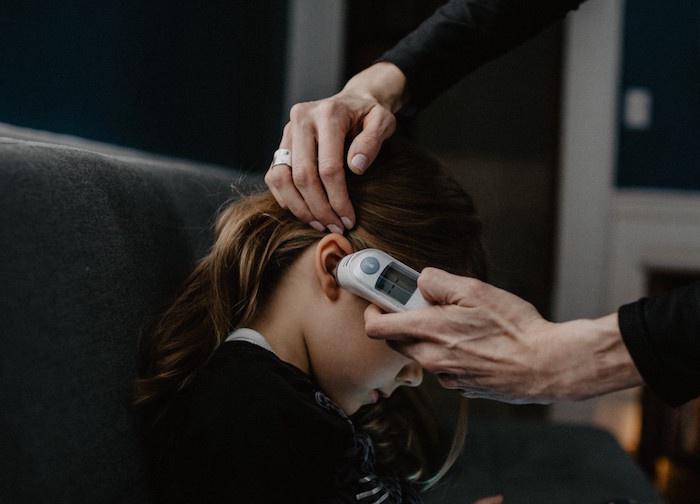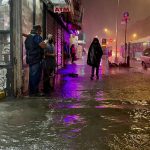
Pediatricians from Massachusetts General Hospital talk about vaccine safety and COVID-19’s dangers, symptoms, treatment and prevention.
From October 2020 to August 2021, the Centers for Disease Control documented more than 4,600 cases of multisystem inflammatory syndrome in children (MIS-C).
© Kelly Sikkema/Unsplash
As children head back to school with COVID-19’s highly infectious Delta variant the dominant strain, parents are facing a rise in child cases the American Academy of Pediatrics (AAP) calls “exponential.” While youth 12 and over are now eligible for the COVID-19 vaccine, younger kids must continue to rely on the adults in their lives getting vaccinated, masks, handwashing and maintaining a safe distance as their primary means of protection.
Parents can take comfort in the fact that COVID-19 doesn’t affect children the same way it does adults. In fact, other respiratory illnesses can be more serious. Still, COVID-19 raises serious health concerns for children.
Not all cities and states report on pediatric COVID-19 cases and deaths. Publicly available data published by the American Academy of Pediatrics indicates that, between May 2020 and early September 2021, nearly 20,000 children have been hospitalized with COVID-19 and 444 children have died. Children’s hospitals are bracing for more cases as the school year gets into full swing. As eager as children of all ages are to resume their lives, Dr. Ronald Kleinman, Physician-in-Chief at Massachusetts General Hospital’s MassGeneral for Children, says they do so from a place of “great insecurity.”
“The COVID-19 pandemic has caused so many children to feel insecure about whether they’ll become infected and what will happen if they do and about whether their parents, siblings and loved ones will become infected and how that will affect their lives,” says Kleinman. “Everything feels uncertain — their schooling, friends, social lives and participation in sports. Unfortunately, far too many children also experience insecurity over having enough food to eat or a roof over their heads.”
Still, Kleinman and clinicians at MassGeneral believe that with safe vaccines for most school-age children on the horizon and the comfort and support of caregivers, kids can come through this pandemic more resilient than ever.
Here, MassGeneral for Children’s Pediatric Infectious Disease Clinical Director Vandana Madhavan and Primary Care & Population Health Management Director Alexy Arauz Boudreau address parents’ questions on everything from COVID-19’s serious health risks for children to how to keep unvaccinated kids from getting sick at school.
We’ve heard that kids don’t get the same severe disease as adults do. Is that still true?
DR. VANDANA MADHAVAN: Due to the relative increase in pediatric COVID cases, we are seeing more children requiring hospitalization and intensive support. However, evidence continues to show that most children who have COVID-19 experience mild to moderate cold-like symptoms. Many kids have no symptoms at all.
Most kids who do get sick will only require such supportive care as medications for fever, fluids and sometimes supplemental oxygen. For severe cases, there are other treatments. Monoclonal antibodies can control the inflammatory cascade that causes pneumonia and other complications. The antiviral remdesivir helps decrease the viral load by keeping the virus from replicating. Doctors prescribe the steroid dexamethasone for patients who have had the infection for several days and developed lung inflammation.
Children who aren’t initially sick can also experience serious illnesses and complications. These include multisystem inflammatory syndrome in children (MIS-C) and ‘long COVID.’ This is significant. We are losing more children to acute COVID than we have to influenza.
Still, it is important to keep the medical impact on children in perspective. The number of children who have developed acute COVID-19 and required hospitalization is relatively small. Of the 19,940 children who have had COVID since May 2020, just .9 percent had to be hospitalized.
What is MIS-C?
DR. ALEXY ARAUZ BOUDREAU: MIS-C syndrome is an inflammatory reaction in the body that occurs about four weeks after infection with the SARS-CoV-2 virus. Most cases are preceded by a positive COVID test though not always. The initial symptoms — often including fever, rashes, red eyes, diarrhea and vomiting — may worsen over a few days. The inflammation can affect the heart, blood vessels and other organs and require urgent care. Children 5 to 9 tend to be most vulnerable, but 1-year-olds have also been affected. The greatest number of cases have occurred among young adults between the ages of 18 and 29.
From October 1, 2020, through the end of August this year, the CDC has documented over 4,600 cases of MIS-C in children. Over half of those are Latino and Black non-Hispanic patients; 41 patients with MIS-C have died.
“We know that the COVID-19 vaccines are effective. We also know that the dangers of COVID-19’s acute and long-term effects for children are more severe than the risks of the vaccines’ very rare side effects.”
Children 12 and over can now get COVID-19 vaccines. Once available, are vaccines safe for younger children?
DR. VANDANA MADHAVAN: We know that COVID-19 vaccines decrease the risk of severe disease and death even if they don’t eliminate the possibility of infection. For some age groups, they may be even more effective. There is little concern that COVID-19 vaccines will be significantly less safe for younger children. Studies underway now are focused on optimal dosing in younger children.
Pfizer’s data shows that 12- to 15-year-olds who received two doses of its COVID-19 vaccine generated antibodies extremely effectively and had an even more robust and effective immune response, besting their near peers, the 16- to 25-year-olds. These findings align with what we know about younger kids’ immune systems; they are healthier and respond more easily. So that will impact the dosage required for children who are likely to get an effective response with a lower dose.
What other factors should I weigh when deciding whether or not to vaccinate my child against COVID-19?
DR. ALEXY ARAUZ BOUDREAU: Whenever you make a public health decision such as to vaccinate or not to vaccinate, it’s important to weigh the risks and benefits to the individual and the community. We know that the COVID-19 vaccines are effective. We also know that the dangers of COVID-19’s acute and long-term effects for children are more severe than the risks of the vaccines’ very rare side effects.
DR. VANDANA MADHAVAN: There are additional considerations: Vaccination doesn’t just prevent acute COVID complications that may require hospitalization and ICU stays. Vaccinations prevent MIS-C in children, teens and young adults. They also protect people from long-term COVID symptoms and provide at least some protection against the variants.
Are there any dangers to vaccinating my younger child against COVID-19?
DR. VANDANA MADHAVAN: The FDA’s June 25 warning about the slight risk of myocarditis after the second dose of the Pfizer and Moderna COVID-19 mRNA vaccines has gotten a lot of press. Myocarditis is an inflammation of heart muscles that can cause chest pains, shortness of breath and increased heart rate. It can also be asymptomatic and picked up during a doctor visit about some other ailment. Myocarditis typically happens within a few days to weeks after the second dose. At MGH, a few cases have appeared as early as three to four days after the second dose.
It’s important to note that the risk is rare. Just 12.6 cases per million have been reported in teens and young adults. Also, other viruses can cause myocarditis — not just SARS-CoV-2, the virus that causes COVID-19. As of mid-June, there had only been approximately 300 total cases in the U.S. While most of those young patients stayed in the hospital for some time, the vast majority recovered.
There is little concern that COVID-19 vaccines will be significantly less safe for children under 12. Studies underway now are focused on optimal dosage for younger children.
© David Veksler/Unsplash
How concerned should I be about my child getting infected with COVID-19’s Delta variant?
DR. VANDANA MADHAVAN: We do not see different symptoms in children infected with the Delta variant than with other strains. As with any other virus, kids with COVID-19 can present with fever, malaise, exhaustion, GI symptoms as well as classic respiratory symptoms.
DR. ALEXY ARAUZ BOUDREAU: The Delta variant’s transmissibility is the concern — especially in areas with low vaccination rates — not necessarily that it’s making children sicker or more likely to be hospitalized. This is being monitored closely, though. The dominance of the Delta variant in the U.S. and the eased restrictions that allow people to go out more and spend time indoors without masks have created the ideal conditions for Delta to flourish and spread to even more people.
Can vaccinated parents give COVID-19 to their unvaccinated children?
DR. VANDANA MADHAVAN: The risk is not zero since we do know that vaccinations don’t offer 100 percent protection. In the early stages of infection, vaccinated adults can transmit the virus to their children — and any susceptible person. That is why we recommend that all who can get vaccinated do. Once vaccinated, your protective antibodies against the virus lower your viral loads so you won’t infect as many people. But now that the highly infectious Delta is the dominant strain in the U.S., we have more to learn.
“While we wait for vaccines [to be approved] for younger children, there are still many ways you can protect your child.”
While we wait for vaccines [to be approved] for younger children, there are still many ways you can protect your child. For example, I always wear a mask when I work at the hospital and spend time in the clinic and office. I also wear a mask when I go indoors to a store or run an errand. When I socialize, it’s outside and mainly with people I feel comfortable asking, ‘Are you sick? Are you vaccinated?’
These discussions can be stressful and even polarizing for families. If possible, think about how to approach the subject nonjudgmentally before having the conversation. That’s the best way to avoid creating more stress for you and your child.
When will I be able to get a COVID-19 vaccine for my children under 12?
DR. VANDANA MADHAVAN: Because there are always many considerations with children, there is a big push to enroll more children in studies. From an infectious disease perspective, there is no concern. The millions and millions of doses of mRNA vaccines administered in the U.S. and worldwide have shown that they are very safe and effective. The priority will be determining the optimal dose for children to ensure a robust immune response without excessive side effects. It’s also crucial to think about the best way to vaccinate children. We are all for children getting the COVID-19 vaccines in primary-care pediatrician offices along with their other immunizations.
In early fall, we hope to get more data from the studies underway and move closer to obtaining the EUA (Emergency Use Authorization) to vaccinate younger kids. Once we have the EUA, we will likely vaccinate children ages 5-11 first, then preschoolers — 2 and over — and lastly children under 2 and infants.
Handwashing, physical distancing and masks at school are still the best way to keep children under 12 from getting COVID-19 until vaccines are approved for younger children.
© Centers for Disease Control and Prevention
How do we keep our children safe until then? Should they wear a mask at school and practice physical distancing?
DR. ALEXY ARAUZ BOUDREAU: The CDC strongly recommends universal masking for children in kindergarten through grade 12 and all staff regardless of vaccination status. Local jurisdictions will decide whether their schools will follow this recommendation. But from a clinical perspective, universal masking makes lots of sense for many reasons.
First: Masking will reduce the chance that unvaccinated children pass the infection on to their classmates and help prevent COVID cases from closing schools. Second: Masking protects kids’ privacy. Requiring masks is like asking children to wear school uniforms. It puts everyone on the same level and relieves social stress especially in middle school. Third: Masks protect immunocompromised children who can’t develop robust antibody responses after vaccination. Fourth: Masks cut down on the transmission of many other respiratory infections, some of which, like the flu, have COVID-like symptoms that would require those students who get sick to quarantine and miss school. Finally, because children who aren’t vaccinated should wear masks, mandatory masking allows teachers to focus on teaching, not enforcement.
What are the potential long-term effects for children who get COVID-19?
DR. ALEXY ARAUZ BOUDREAU: We still don’t have enough children who have been affected by long COVID to draw firm conclusions. But we are closely watching cases we have in a clinical study here at MGH and those throughout the country.
From what we have seen, long-term COVID, which presents as new symptoms from acute COVID or ongoing symptoms, can affect children to a lesser degree than it does adults. It can last weeks to months after acute infection. Therefore, in children, it is a concern. Treatment typically requires multidisciplinary support from cardiologists, pulmonologists and neurologists, given all the organs that can be affected. Symptoms can include persistent shortness of breath, fatigue, difficulty concentrating, persistent cough, chest or stomach pains, palpitations, joint and muscle pains, pins and needles, diarrhea, sleeping issues, fevers, dizziness, rash, even mood changes.
“The CDC strongly recommends universal masking for children in kindergarten through grade 12 and all staff regardless of vaccination status.”
There has been much news coverage about how the pandemic has hit Black and Hispanic people especially hard. How are children in your practice coping with the impact of COVID-19 on their communities?
DR. ALEXY ARAUZ BOUDREAU: COVID-19 has shone a spotlight on how our society’s inequities affect health and health outcomes. COVID-19 has been more prevalent among Black and Hispanic people, with more frequent hospitalization and long-term consequences and death. In addition, Black and Hispanic children are more likely to have a parent or know someone who has died of COVID-19.
Black and Hispanic people also face more difficult psycho-social circumstances. They are more likely to experience financial difficulties due to COVID-19, including food insecurity and housing issues. Connectivity issues at home may have made remote learning more difficult for their children, who often attend schools with fewer resources. Finally, income constraints usually mean families can’t afford large homes, making social distancing and shutdowns harder to bear. Two of my patients come to mind: A 10-year-old whose parents were both hospitalized in April 2020 for over a month. His adult sister moved back to care for him, but when she also contracted COVID-19, the child had to become the caregiver. I have another patient in 7th grade whose teacher scolded him for keeping his camera off during lessons. He did so because, with three other siblings at home attending school on Zoom, the bathroom was the only place where he could attend class in relative quiet.
We have spent a lot of time talking about the physiological effects of COVID-19 in children. But by far, the psychological trauma inflicted on all children is the most significant consequence, and COVID’s toll on Black and Hispanic children has been unfairly harsh. We are fortunate human beings evolved to adapt, and children are incredibly resilient. With the proper support, tailored to each child’s needs, this collective trauma can be an opportunity to help children and teens build resilience and move forward.
As part of the COVAX facility, UNICEF is working to deliver 1.48 billion COVID-19 vaccine doses to more than 180 countries in 2021 — along with treatment and diagnostic kits, masks and hygiene supplies. No one, including children, is safe until everyone is safe. You can help.







